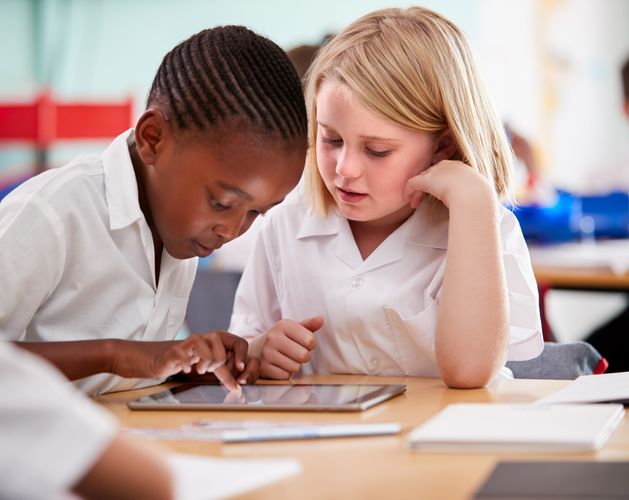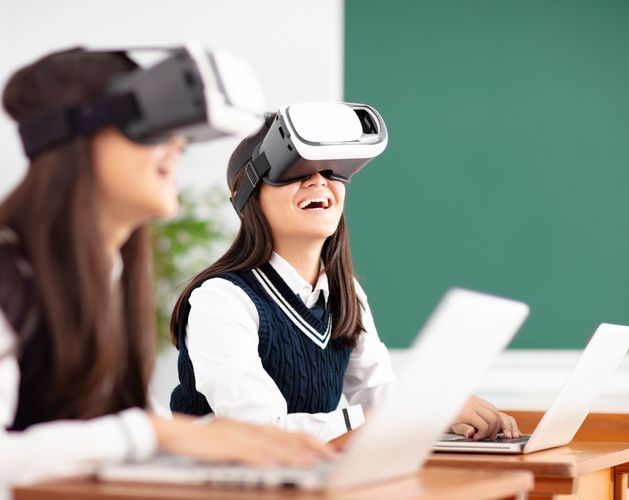The annual BETT show at the ExCeL in London is the marquee event in the education technology calendar.
The theme of BETT 2022 was Create the Future, and Softcat was proud to sponsor this year’s exhibition. I was excited to see so many insights into the future of education on display, and like many people, I really enjoyed the buzz of being back at a live event.
Over the last couple of years, technology has enabled millions of students to maintain access to education, and educators have showed amazing resilience in coping with the toughest of circumstances.
But as well as looking back, it was great to see so much of BETT focus on how education stakeholders will be able to meet their challenges and needs in the future, as these examples show.
Spotlight on the metaverse in education
I’ve been fascinated by the idea of the metaverse for a while, especially in terms of its power to open up new ways of learning, and its potential to offer rich, collaborative experiences for remote learners. So I was really pleased to see this topic generating real interest during the BETT event.
A metaverse is a virtual interactive digital world, much like the environments in which video games are played. All kinds of activities can take place within these environments, including learning as well as gaming and commercial transactions. They offer a great way for students to acquire digital, creative, and problem-solving skills, as well as interacting with specific environments – from virtual prehistoric worlds to exploring the mysteries of the universe.
Metaverse creators vary in size and focus, from start-ups to tech giants like Meta and Microsoft. In fact, Microsoft’s Minecraft is the perfect example of an metaverse, where students can move forward with code, logic and troubleshooting skills, and many more besides.
New ways to learn
Metaverse environments can benefit children and students at every stage of the education ladder. For reception-aged pupils, for example, where project-based learning is proven to help children engage with a range of topics, a metaverse can provide ways for students to interact with areas like money, maths, graphs, and science within a rich, immersive, and interactive environment. Metaverses offer students incredible opportunities to learn at their own pace and in their own ways, working on their own, or in groups where they interact with their peers.
As yet, the cost of the headsets required to access these worlds in full 3D puts them out of reach for mass use in schools. But I was encouraged to see how interacting with metaverses via affordable devices like smartphones and tablets is increasingly realistic.
The world at your fingertips
I’m especially interested in how these innovations have the potential to enhance private tuition. Immersive worlds full of rich interactive content coupled with private tuition has the potential to allow students to grow their knowledge more quickly and enjoyably than ever before, potentially using their own home-based equipment.
As the home tutoring market in the US looks set to almost double between 2020 and 2028, and become a $170 billion industry, metaverses have the potential to bring home tuition to life in richer ways than ever before, improving education outcomes for millions of students.

Education leadership in focus
Head teachers and senior leadership teams (SLTs) in schools and colleges now have a huge digital dimension to their roles. Technology already played a critical role in education and learning pre-pandemic. But now, after two years of on-off remote learning, digital technology has permeated every aspect of management, teaching, and learning.
As a result, education leaders find themselves needing to drive a digital transformation programme in their establishments, building on the changes that were made during the pandemic.
I’m certainly seeing first-hand how the IT challenges facing education leaders are growing in complexity, and I doubt many head teachers went into their profession to deal with issues like cyber security insurance. At Softcat, we work with a large number of schools and colleges. We work hard to make sure we provide the diverse and dynamic support our education customers need as they go through a period of profound change – always while commanding best value for money.
In January 2022, the education sector accounted for over 80% of all reported malware encounters.
Creating brighter futures
The last 18 months has seen schools and colleges forced to become ‘future ready’ almost overnight, and they have been heroic in making tremendous progress under the most difficult of circumstances. These changes reflect the accelerated use of technology and the switch to alternative models of education, especially remote learning.
However disruptive these experiences may have been, they are an undoubted catalyst for innovation and modernisation, enabling educators to:
- React to changes in ways that pioneer new education models.
- Keep pace with students’ digital experiences in their lives beyond the school gates.
- Help students get equipped to use digital technology in the world of work.
In the work we do with schools and colleges, we work with SLTs to establish a vision for the future of their establishment and help develop IT strategies and roadmaps to realise their vision, while best serving the needs of students and teachers.
1.4M Pupils in England have SEN
Supporting and enhancing inclusion
This year saw a big focus on how best to meet the needs of the growing number of students with special educational needs (SEN) – currently over 12% of UK pupils. Schools and colleges are under growing pressure to ensure SEN pupils feel welcome and included. But this is an increasingly tough challenge given the backdrop of budget cuts, and experienced teachers leaving the profession.
I was heartened to see the innovative ways in which technology continues to evolve to help teachers make sure everyone in the lesson has access to learning and feels included.
I see first-hand how technology is increasing access and inclusivity, from assistive capabilities in all widely used operating systems to voice recognition and enabling pupils to learn using their own devices that have been customised to meet their specific needs.
Promoting wellbeing for all
No surprise that wellbeing was a key theme at this year’s BETT, with a focus on the stark realities and challenges facing pupils’ mental health today. Teachers are reporting ever-increasing levels of stress, anxiety and other mood disorders in the classroom, and access to treatment and therapies is increasingly constrained.
And of course, the same is true for academic staff, who have also endured a period where their resilience has been tested to the limit. With many teachers wanting to leave the profession, establishing a culture focused on wellbeing will help staff to flourish in challenging times.
I agree wholeheartedly with consensus on the importance of fostering wellbeing systems that provide a safety net for the vulnerable, promote resilience, encourage openness about mental health issues, and look to manage workloads. And I feel optimistic about supporting schools with education technology solutions that ease some of the pressures facing pupils and teachers, for example with tools that help automate workload planning, or streamline communication between teachers and parents or guardians.
Acquiring and developing skills
In our increasingly digital world, the workers of the future will need digital literacy as much as creative and critical thinking. Which means educators themselves need the right skills to lead the way for the next generation.
But when technology evolves so fast, and industries and working patterns can be transformed almost overnight, who decides which skills will be the most valuable? At the same time, skills in areas like creativity, abstract thinking and team working may prove to be the most valuable as more repetitive tasks become the preserve of AI and computerisation.
While these philosophical questions are probably too big in scope for me to answer alone, the Softcat team and I always look to share our knowledge with our education sector customers. By informally offering insights on emerging trends, schools can gain early awareness of new innovations like the Metaverse example I touched on earlier.
51% of UK students reported that university had not sufficiently prepared them for the world of work
Accelerating innovation
BETT is always a great place to experience smart new solutions for all levels of the education system.
It was great to see a focus on all kinds of innovations, not just in education and learning but in areas like promoting student retention, involving parents and guardians in children’s learning, course design and assessments, and much more besides.
This is especially the case in higher education, where competition for student remains acute, and innovative technologies can prove a differentiator in offering innovative and appealing ways to access learning.

